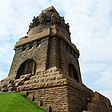BACH MUSEUM - LEIPZIG
Treasures of the Baroque Composer and St Thomas Choral Master
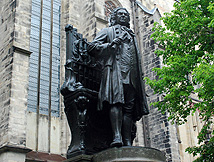 One of the greatest composers of the Baroque age, Johann Sebastian Bach (1685-1750) was not born in Leipzig, but after accepting the post of cantor of the St Thomas Church in the Saxony city in May 0f 1723, one of the most creative periods of his life was shaped by one of Europe’s cultural and economic centers. Leipzig is connected to a long list of creative figures who lived or studied there, Richard Wagner (see Young Richard Wagner), Goethe, Mendelssohn among them. The St Thomas’ Church and its Choir and music school were and still are one of the leading musical institutions of Germany (see St Thomas Church) and the position of Cantor and Choirmaster (Kapellmeister) there was a prestigious one. Bach composed some of his most important works while directing the St Thomas’ Choir in Leipzig, including the Mass in B Minor, the Christmas Oratorio, St John’s and St Matthew’s Passions, and the Art of the Fugue.
One of the greatest composers of the Baroque age, Johann Sebastian Bach (1685-1750) was not born in Leipzig, but after accepting the post of cantor of the St Thomas Church in the Saxony city in May 0f 1723, one of the most creative periods of his life was shaped by one of Europe’s cultural and economic centers. Leipzig is connected to a long list of creative figures who lived or studied there, Richard Wagner (see Young Richard Wagner), Goethe, Mendelssohn among them. The St Thomas’ Church and its Choir and music school were and still are one of the leading musical institutions of Germany (see St Thomas Church) and the position of Cantor and Choirmaster (Kapellmeister) there was a prestigious one. Bach composed some of his most important works while directing the St Thomas’ Choir in Leipzig, including the Mass in B Minor, the Christmas Oratorio, St John’s and St Matthew’s Passions, and the Art of the Fugue.
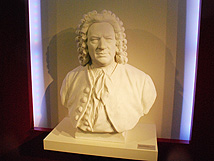 The Bach Museum of Leipzig is located in the Bose House, one of the oldest buildings in Leipzig, acquired in 1710 by a wealthy merchant Heinrich Bose who had it restyled from an earlier Renaissance structure. The Bach family lived in an apartment of the St Thomas School across the street, which was torn down in 1902. Here you’ll discover that Bach came from a musical family, with ample evidence provided by the Origins of the Bach Family Tree provided by the composer himself, who at 50 complied biographical notes on 53 members of his family, almost all cantors, organists and court musicians, and his descendants continued the family business, Bach’s tree only goes as far as his son, but later generations continued the tradition.
The Bach Museum of Leipzig is located in the Bose House, one of the oldest buildings in Leipzig, acquired in 1710 by a wealthy merchant Heinrich Bose who had it restyled from an earlier Renaissance structure. The Bach family lived in an apartment of the St Thomas School across the street, which was torn down in 1902. Here you’ll discover that Bach came from a musical family, with ample evidence provided by the Origins of the Bach Family Tree provided by the composer himself, who at 50 complied biographical notes on 53 members of his family, almost all cantors, organists and court musicians, and his descendants continued the family business, Bach’s tree only goes as far as his son, but later generations continued the tradition.
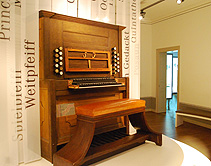 Bach's favorite instrument for his compositions was the organ and the museum holds the console of the only known organ still existing at which Bach himself sat and played. Only parts of the original organ remain, some of it lost in the 19th Century and suffering heavy futher damage in the WWII bombing of Leipzig, but the console front has been restored as closely as possible to what Bach himself would recognize.
Bach's favorite instrument for his compositions was the organ and the museum holds the console of the only known organ still existing at which Bach himself sat and played. Only parts of the original organ remain, some of it lost in the 19th Century and suffering heavy futher damage in the WWII bombing of Leipzig, but the console front has been restored as closely as possible to what Bach himself would recognize.
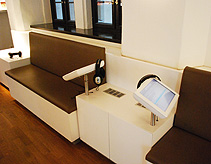 The organ was only one of the tools of a composer and a room at the museum is devoted to the various historical instruments of the Baroque period of Bach’s time. Bach was himself fascinated with the way instruments worked and in their tuning and acoustics. He made use of a wide range of tonal qualities in his work with new instruments being developed which he added into his compositions. In the instrument room you find the now curious, oboe d’amore and the bassoon grosso, which contributed to his sound. An interactive “wall orchestra” offers visitors and opportunity to explore how the instruments sound in a range of works from the virtual baroque orchestra. Press a button and the corresponding sound is amplified. The full sounds of Bachs’ compositions can be enjoyed and studied in the listening room, with earphone stations at comfortable cushioned seats. A Film Studio room is dedicated to the films and documentaries which have featured Johannes Sebastian Bach.
The organ was only one of the tools of a composer and a room at the museum is devoted to the various historical instruments of the Baroque period of Bach’s time. Bach was himself fascinated with the way instruments worked and in their tuning and acoustics. He made use of a wide range of tonal qualities in his work with new instruments being developed which he added into his compositions. In the instrument room you find the now curious, oboe d’amore and the bassoon grosso, which contributed to his sound. An interactive “wall orchestra” offers visitors and opportunity to explore how the instruments sound in a range of works from the virtual baroque orchestra. Press a button and the corresponding sound is amplified. The full sounds of Bachs’ compositions can be enjoyed and studied in the listening room, with earphone stations at comfortable cushioned seats. A Film Studio room is dedicated to the films and documentaries which have featured Johannes Sebastian Bach.
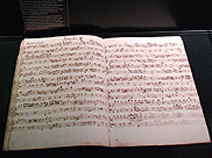 The Treasures Room houses a collection of precious and delicate articles and papers from Bach’s life and career, sheets of music scores, manuscripts and documents written by the composer in his own handwriting and prints. Some of the most unique and valuable of the originals at the Bach Museum are the 44 sets of Bach’s Cantata Chorale. Shortly after beginning his position as cantor, he began one hos his most ambitious works, composing a sacral cantata for every Sunday and Feast Day of the church calendar to be performed at St Thomas’s or the St Nicholas Church. A complete set of parts of these pieces is on display in the collection.
The Treasures Room houses a collection of precious and delicate articles and papers from Bach’s life and career, sheets of music scores, manuscripts and documents written by the composer in his own handwriting and prints. Some of the most unique and valuable of the originals at the Bach Museum are the 44 sets of Bach’s Cantata Chorale. Shortly after beginning his position as cantor, he began one hos his most ambitious works, composing a sacral cantata for every Sunday and Feast Day of the church calendar to be performed at St Thomas’s or the St Nicholas Church. A complete set of parts of these pieces is on display in the collection.
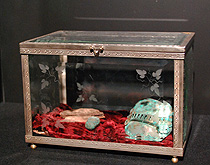 Small items presumed to be from the gravesite of Bach and his wife Anna Magdalena who were buried side by side in St. John’s Cemetery in Leipzig. Over a century the actual grave location was forgotten, but in 1894 a commission was formed to establish the gravesite and some small objects in a glass case, splinter fragments from an oak coffin, a clasp and a thimble thought to have been in the grave have been kept as relics, first at St John’s Parish for 100 years, and now moved to the museum. A burial marker of Johann Sebastian Bach can be found in St Thomas’ Church, facing the altar and usually draped with flowers, where bones found at the presumed grave were relocated.
Small items presumed to be from the gravesite of Bach and his wife Anna Magdalena who were buried side by side in St. John’s Cemetery in Leipzig. Over a century the actual grave location was forgotten, but in 1894 a commission was formed to establish the gravesite and some small objects in a glass case, splinter fragments from an oak coffin, a clasp and a thimble thought to have been in the grave have been kept as relics, first at St John’s Parish for 100 years, and now moved to the museum. A burial marker of Johann Sebastian Bach can be found in St Thomas’ Church, facing the altar and usually draped with flowers, where bones found at the presumed grave were relocated.
A marble bust inside the entrance of the museum of Johann Sebastian Bach at about the age of 60 was sculpted by Carl Seffner after a mold from a skull found in Bach’s presumed grave in 1894 was modelled by 19th Century anatomist Wilhelm His, and comparing the skull to various contemporaneous painted portraits. The same sculpted image can be found at the Bach Monument erected at the instigation of Felix Mendelssohn Bartoldy in St Thomas’ Square in 1908 (see Mendelssohn House).
Visiting the Bach Museum in Leipzig
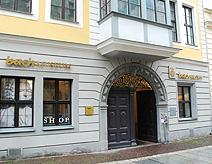 Opening times are 10am to 6 pm Tuesdays through Sundays and public Holidays (except December 24, 25 and 31). Admission is €8 Adults, €6 Students and Seniors, Children under 16 are free. The museum is located in the Bose House at the southern side of the St Thomas’ Church Courtyard. The museum entrance is in a small garden courtyard in the building, a rare feature for houses of this time, where Bach and his family might have spent some relaxing hours visiting the neighbors. Special exhibitions are held at the museum, and live concert recitals are held in the neighboring Summer Hall. Or have a snack at the Johann S. Restaurant nearby. © Bargain
Travel Europe
Opening times are 10am to 6 pm Tuesdays through Sundays and public Holidays (except December 24, 25 and 31). Admission is €8 Adults, €6 Students and Seniors, Children under 16 are free. The museum is located in the Bose House at the southern side of the St Thomas’ Church Courtyard. The museum entrance is in a small garden courtyard in the building, a rare feature for houses of this time, where Bach and his family might have spent some relaxing hours visiting the neighbors. Special exhibitions are held at the museum, and live concert recitals are held in the neighboring Summer Hall. Or have a snack at the Johann S. Restaurant nearby. © Bargain
Travel Europe
Find best hotel and vacation deals in Leipzig on TripAdvisor
Web
Info
Bach Museum
These articles are copyrighted and the sole property of Bargain Travel Europe and WLPV, LLC. and may not be copied or reprinted without permission.
See Also:
GRASSI MUSICAL INSTRUMENT MUSEUM
AUERBACHS KELLER - GOETHE INSPIRATION LEIPZIG
MUSEUMS OF THE ZWINGER - DRESDEN
BRUSSELS
MUSICAL INSTRUMENT MUSEUM
BATTLE OF NATIONS MONUMENT LEIPZIG

